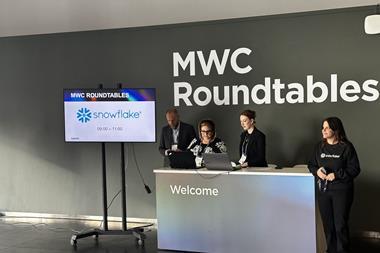- AI data cloud company Snowflake is ready to answer the call from operators seeking a new collaborative mindset with partners and customers in the emerging digital era, and has a plan for identifying and addressing the changing needs of modernising telcos.
- Change is coming, moving quickly is vital, and a data platform-led approach can deliver consistent and replicable access to critical insights without distracting infrastructure overhauls that drain time and money.
- An effective platform for data does more than streamline operations, unifying an accessible source of valuable business information to be leveraged by business teams, unlocking new use cases and commercial opportunities, and enabling a ‘BizCo’ transformation.
- Technology change is only half the battle for operators pivoting towards data-driven operational and business models, and partners that understand internal friction and bring experience and alliances to support growth in new industries are crucial.

As operators advance on the restructuring and redefinition of their operations for the new data-driven digital era, the message emerging from European telco giants including BT, Telefónica, Telia and Vodafone is that the relationship between telcos and technology suppliers also needs to be reshaped, with a tangible pivot towards genuine partnership.
This was crystallised at a TM Forum discussion this summer, where a gathering of chief information and technology officers from major global operators agreed the need for a reset of the operator‑supplier dynamic, with Abdurazak Mudesir of DT calling for “a hyper‑collaborative approach”, and Vodafone’s Scott Petty reflecting on the ongoing “big change journey” needed for these relationships.
This recalibration is being welcomed by the telecoms leadership team at Snowflake, and is reflective of the data cloud innovator’s experience in working with both established scale players and emerging disruptive challengers within the sector.
Snowflake has been finessing its own approach to best advance this reset for the telco industry with a data platform central to these foundations, setting its sights on enabling the critical transformation strategies that will evolve into partnerships delivering meaningful change.
Speaking to TelcoTitans, Snowflake’s telco leadership outlined this vision, demonstrating a willingness to embrace telco enthusiasm for greater collaboration with their data enablement solutions, as well as addressing some hard truths. Their goal is to promote transformation that goes beyond telco to TechCo, ultimately into territory that could be called BizCo to best meet the needs and opportunities of B2B for operators.
Snowflake’s telco data vision: collaboration, consistency and clarity

For Phil Kippen, Snowflake’s Global Head of Industry for Telecommunications, building partnerships that go beyond platitudes demands a willingness to dig deep on the challenges faced by the sector.
“We work best with customers or prospective customers who engage in the conversation of business problems”, he says, “working together and asking the right questions means we can help come up with answers”.
Operators need to adapt traditional commercial strategy to evolve their customer relationships in a way that reflects the demands and expectations that accompany digital services. They need to upgrade internal capabilities to effectively — and efficiently — operate data‑driven network infrastructure and operations that substantiate this opportunity. And they need to do this quickly.

Jonathan Pick, Global Account Director for Telco at Snowflake, sees a key element of enabling this internal transformation as ensuring there is consistency on data across the entirety of the business, which is not currently there. Doing this, he recognises, is easier said than done. Operators now exist in a multi-cloud world, with organisational structures that feature diverse and often geographically dispersed business units firefighting immediate challenges while at the same time trying to plan for future developments.
Helpfully, Pick considers the answer to addressing these varied and potentially conflicting does not need to be complex. “Operators can get beyond point-solutions for individual problems with a data platform approach that doesn’t try and break down silos, but instead exists above them”, he explains, “and the potential for this to enable new solutions and tools that can be scaled multiple times across entire network operations is powerful”.

Meanwhile, Sreedhar Rao, Snowflake’s Global Telecom CTO, emphasises the importance of having clarity on data that lasts beyond a handful of days, pointing to granular information that can deliver visibility and a depth of insights not possible when it is aggregated too quickly or too often. “Right now, operators are losing information, and they aren’t able to make fully informed decisions”, he warns.
While embedding data-enablement at the heart of telco is nobody’s idea of a simple task, Kippen reads a willingness to take on the challenge evident in this summer’s declarations by leading sector CTOs, and he wants to ensure Snowflake is equipped to play its part as trusted advisor.
Snowflake already fulfils this partnering role with notable incumbent, greenfield, disruptor, and consolidating operators around the world, and an area of growing importance is the need to provide clients with support for where their worlds of data, network and operations are rapidly coming together — and making sure these don’t clash.
New network technologies = data-driven opportunities
Snowflake takes a long‑range view on the role of data in the reorientation of the telecoms sector, and for operators to reach their goals they need to have the foresight to start acting now.
“6G is going to come hard”, notes Kippen, with operators needing to prepare for new ways of approaching systems and services and network management and monitoring, all underpinned by data.
“Where operators need to get to is ‘data‑driven’”, he believes, “and at Snowflake we’re trying to simplify that”. This simplification might be enabled through embracing GenAI capabilities that make platforms easier to interact with, and data more meaningful.
Kippen says Snowflake is now regularly engaging with customers in conversations linked to GenAI. A key factor that operators often overlook when developing a GenAI strategy, he suggests, is “you need a data platform that provides the capabilities the technology needs: this isn’t just a question of compute and network power”.
“ In the operations area, you’ve got a lot of different OSS platforms, each with a very specific way of doing things, so when you look at trying to bring GenAI into those OSS platforms, does it make the problem worse or does it make the problem better? Right now, just taking those systems and trying to bring GenAI into them is the wrong approach. It should absolutely be built in a platform that is made for not just GenAI, but machine learning and other capabilities as well. ”
Kippen.
A current challenge for operators is tackling traditional on‑premises infrastructure where “they basically have their data locked up and can’t do anything with it”, according to Rao. Materially changing this could prove a huge time‑consuming effort in a period when speed is key. Delivering the on-premises hardware needed to enable meaningful access to currently siloed data could easily be an 18-month project.
Rao suggests operators should instead be looking at a platform like Snowflake’s that can enable access no matter where the data sits, using open data formats like Iceberg with a centralised governance architecture.
“ Ideally, it would be great if you can move all the data into Snowflake in a cloud environment, but the value that we bring as a platform with open data format support is that we are also able to work with data in a federated manner while providing the processing bandwidth needed for advanced AI and ML use cases without operators having to maintain all that compute infrastructure for the workloads on-prem, which is critical because these workloads are not steady and not suited to ‘peak engineering’. ”
Rao.
Kippen cites work underway at tier-1 operators partnered with Snowflake that are leading the way on platform adoption. With investment and resources committed to building “phenomenal” data platforms, and with internal teams closely aligned, these pioneers are already “in phase two” of their data‑driven platform development.
“ The first thing you’ve got to do as a service provider is build that platform: These major outlier CSPs have done that. The next question for them is how do they bring users onto the platform, and how do they make data part of a daily routine?
One of them, by focusing on open-source Apache Iceberg data tables and other capabilities that are more open as a means of leveraging its data, has put itself in a position where it can build a broad ecosystem and not have to worry about integration. Contrast that to what usually happens in OSS today, where you would have to have a massive amount of integration… ”
Kippen.
This next phase of data platform adoption entails targeting advanced use cases that can be built on common components. By using this approach to drawing out data sources traditionally confined within the OSS environment, operators can find an answer to Kippen’s question: “now you’ve got the platform, how do you change your processes in such a way that will absolutely help more users interact with that data?”.
Supporting OpCo optionality while maintaining a Group steer
Another notable way that Snowflake can support collaboration is internal collaboration within complex groups, highlights Pick.
He notes that larger groups can have multiple operating businesses and Group functions working with a degree of autonomy and across borders. There may be multiple OSS or BSS systems in play and a challenge, says Pick, is achieving a balance of localisation while maintaining an aggregated perspective “when data is going to be flying around all of those businesses all of the time and everyone is using different analytics”.
The answer, he believes, can be found in delivering shared architecture through Snowflake, which means apps can be deployed centrally and distributed downstream regardless of the tools being used. This approach can also extend collaboration with partner and customer networks.
“ Because of the way our platform is architected and because we run all the compute and storage infrastructure, it doesn’t matter if an organisation is using AWS, GCP or Azure for a cloud platform. It’s the same version of Snowflake. That means thousands of organisations can set up collaboration querying data and sharing resources without the data ever leaving their account. ”
Pick.
Data‑driven at different ends of the spectrum
Snowflake’s client base in the communications sector runs the gamut from greenfield challengers to established global leaders, and Kippen notes that the challenges faced, and nature of requirement, can be equally variable.
For example, Snowflake is a key partner for Eutelsat OneWeb’s low‑Earth orbit communications business, where it is playing an instrumental role in building a platform to manage the operation of its satellites, as outlined at TM Forum’s DTW-Ignite conference in Copenhagen earlier this year. “OneWeb is a very lean organisation”, notes Kippen, “and when you look at the value our platform is bringing to OneWeb, it is effectively providing an OSS platform, but it’s not the OSS platform that a traditional wireline or mobility service provider would expect to see”.
Major incumbents use Snowflake’s platform “in a totally different way”, traversing a huge variety of use cases to address business problems. With substantial resources focused on network planning, operations and engineering, Kippen notes that one of these is also leveraging Snowflake for cross‑collaboration with adtech and content teams, and examining different business models that can impact customer experience. Open RAN greenfield disruptor DISH Network and incumbent Spark New Zealand are other transformative operators drawing on Snowflake to transform their data-centricity.
The key, Kippen believes, is having a clear vision that fits the objectives, and making sure everyone is on board.
“ My recommendation to providers is to really focus on making sure that multiple business functions are engaged in conversations, and that you have a specific goal and a journey in mind. That journey for mobile providers is really getting to data‑driven architectures. With that goal in mind, it becomes much easier for us to look at what are the requirements and how do we bring that data in. ”
Kippen.
Lightbulb moment: data availability becomes self-fulfilling
Snowflake considers that operational data presents a huge opportunity for telcos to both drive efficiency and unlock innovative new services.
However, as Rao notes, many only maintain extensive data for a matter of days, which could be closing off the potential for deeper understanding of their businesses.
In dramatic contrast, Rao suggests a better cycle would be a three-year window for data that can feed into improved models enabled by new AI/ML tools, to provide more accurate insights including around seasonality as well as maintain short‑term functionality.
In this model, existing dashboards remain, but with Snowflake enabling a parallel dimension for operators to interact business-wide with their network and other data that can be used to better react to situations such as a service outage. “You can ask, in simple language, what customers have been affected by a cell site being down and get a quick answer without opening an IT ticket”, he says.
Operators struggle to make existing data useful within commercial decision‑making processes in a timely manner, but a platform approach can overcome this. “We can bring visibility into that data without having to move it”, Rao says, “and we have the tools to make that data speak to business users”. And once business-wide data capability is introduced, further use cases build.
“ We are working with our customers to create these interactions. When you put that power in the hands of the business users, then lightbulbs click on in their heads, and once they know the data exists it sparks new ideas. They’re creating new ideas, new opportunities, and new use cases that can be monetised. ”
Rao.
Making valuable data accessible via a new platform might not happen overnight, but it can be enabled within a couple of months, says Kippen, with a similar timescale to release self‑service dashboards meeting the new requirements. Globe Telecom in the Philippines has undertaken this journey with Snowflake, building self‑service analytics capabilities and leveraging the platform for B2B services within the space of roughly one quarter. And once that capability is up and running, timeframes for new use cases are dramatically reduced.
Driving internal collaboration and its synergistic opportunities is a vital step to get to transformational benefits, believes Kippen, enabling implementation of ‘smart capex’ solutions, energy management, and delivery of digital twin capabilities that will come into their own with the latest evolution of 5G and the advent of 6G.
This ties in directly with telco CTO ambitions. As Vodafone’s Petty recently noted, “if you want to be successful, it’s a partnership between the business leaders and the technology leaders to build products that can be successful in the marketplace”.
Fight the power (bill) — 25% at a time…
Power consumption is an example of where Snowflake considers its data platform can have an immediate significant impact on telco operations and where it is partnering as an enabler.
Rao notes customer conversations where available input is little more than an aggregated bill from an energy producer, providing no visibility, while in other instances operators are overwhelmed with granular information but have no means of utilising it — “it’s just collected, stored, and then thrown out after a while”, he says. He suggests “the holy grail” for the operators would be actionable visibility into power consumption across every element of the network, both cloud and on-premises.
The RAN is a particular area where the potential benefits of energy efficiency stand out, with an estimated 70% of power consumption linked to the access network. However, while 5G has advanced, the range and depth of available energy data has remained variable and fragmented, says Rao. Despite new energy optimisation techniques, and open RAN bringing additional tools, there remains no model that can connect all the data sources. Vendors can measure power differently, with no standard approach to timeframes or components measured, while approaches to optimisation similarly vary. Operators, therefore, need a holistic view that breaks energy data out of the silos.
“ What we are saying is, let’s get visibility into that data. Next, let’s analyse that data. And, then, let’s take actions based on that data. We are finding that even in a single vendor environment, if we can analyse the available data, we can actually improve efficiency by 10%–15% on top of any efficiency measures the vendor has in place. ”
Rao.
Snowflake is partnering with IoT sensor vendors to bring a broad range of data together, with an IoT bridge that delivers pre‑built functionality seeing sensor data streamed directly into the platform.
More than a TechCo: becoming a BizCo
The technological obstacles for operators set on becoming digital players able to leverage the strength of their data are considerable. However, Rao is optimistic that operator’s technical skills are up to the challenge — “telcos have been TechCos from day-one. Just look at the constant cycle of network technology evolution”.
He does, though, consider it vital that operators build different relationships as they continue working in a more data‑driven environment, and demonstrate their relevance to B2B decision‑makers who are more fluent in “IT language”.
“ What I think is important is to transform into what I would call business companies — a BizCo as well as a TechCo. That’s the missing piece; working out how to make digital technologies work for them. They should be thinking ‘what is the business need?’, and then ‘how do I bring these technologies to work for me?’, to answer that. ”
Rao.
A key challenge will be achieving a firm grasp of the impact of ongoing changes in operators’ architecture, including the switch from vertically- to horizontally-integrated operations and systems. Rao highlights that operators will particularly need to manage infrastructure layers that support delivery of infrastructure, platforms and software ‘as-a-service’, while avoiding the danger of new silos emerging.
“ When you’re flattening architecture in this way, we say ‘Don’t look at the components as infrastructure or software, look at it as data — what is it telling you, and how do you incorporate that in your processes?’. When you have that understanding of the data, let’s make it a business. ”
Rao.
Kippen, meanwhile, sees Snowflake playing a role in bringing operators closer to enterprise customers through Snowflake Marketplace, where secure data-sharing and potential for monetisation of apps, data and AI models foster creation of new solutions and alliances that strengthen analytics capabilities.
He also highlights the input over the past 18 months of Salesforce veteran Tyler Prince who, as Global Leader for Alliances and Channels for Snowflake, is influencing the direction of the business’s development with a focus on bringing expertise across different segments onto the Snowflake platform.
“ We have to bring the ecosystem together in a way that delivers value for complex use cases. When Tyler came in, he brought a partner and alliances strategy, which really focuses on bringing expertise so we can go and add additional capabilities to the platform, bringing ecosystem partners together. And we’re able to do it in a way where service providers can have the flexibility to pick and choose the solution that works best for them. ”
Kippen.
Topics
- 5G
- 6G
- Abdurazak Mudesir
- AI/GenAI/ML (artificial intelligence, agentic, machine learning)
- BSS/OSS
- BT Group
- Capex (capital investment)
- Cloud
- Collaboration
- Data
- Data science (analytics)
- Digital transformation
- Digital twin
- Digitalisation
- DTW Ignite (TM Forum)
- Enterprise (B2B)
- Eutelsat
- Industry Voice
- IoT (Internet of Things, M2M)
- Jonathan Pick
- Microsoft
- OneWeb
- Open RAN (ORAN)
- Phil Kippen
- RAN (radio access network)
- Scott Petty
- Snowflake
- Sreedhar Rao
- Strategy & Change
- Technology
- Telefónica Group
- Telia
- TM Forum (TMF)
- Vodafone Group



































